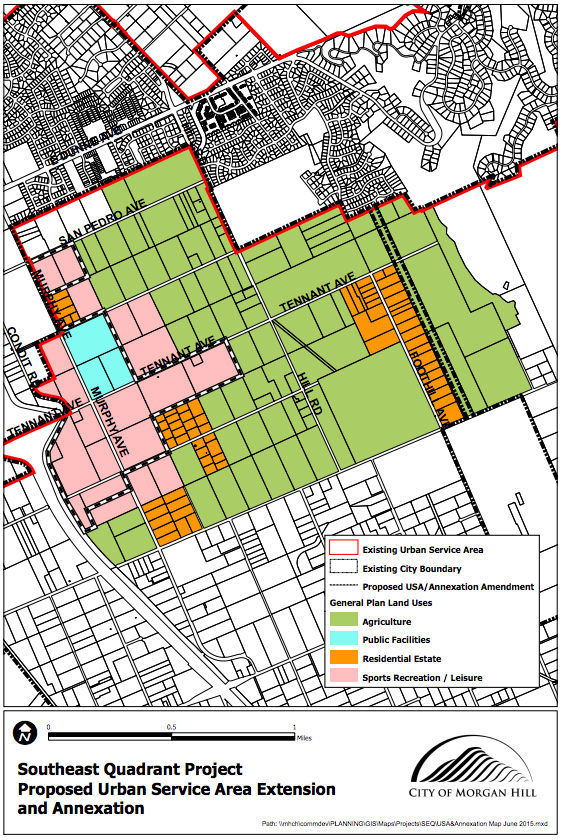
With one of their colleagues doubting they will be able to preserve a vast amount of farmland, the Morgan Hill City Council approved the long simmering Southeast Quadrant annexation, land use and agricultural preservation plan last week.
The council voted 3-1 July 15 to send the plan to the Santa Clara County Local Agency Formation Commission (LAFCO), which will be tasked with the effort’s ultimate approval. Councilmember Rich Constantine voted against the plan, and Councilmember Marilyn Librers was absent from the meeting.
The complicated plan required a series of 10 separate votes by the council. These include:
• Amending the city zoning code to include an agricultural mitigation plan and a new “sports/recreation/leisure” land use classification;
• Extending the “urban service area” boundary in the SEQ;
• Requesting of LAFCO the annexation of 215 acres into the city limits;
• Pre-zoning a 38-acre parcel “public facilities” where the San Jose Diocese plans to build the South County Catholic High School;
• And applying the new SRL classification to several private properties in the SEQ.
Constantine voted “no” to each item in succession at the July 15 meeting. He noted that the many agencies and environmental groups that are likely to be affected by and involved in the plan have repeatedly said the city’s SEQ document falls far short of its stated goals to preserve agriculture and open space. These include LAFCO staff, the county itself, the Santa Clara Open Space Authority and private nonprofits.
Constantine stressed after the July 15 meeting that he is not opposed to sustainable, responsible development nor the SEQ plan as a concept.
“I don’t want to stop the process,” Constantine said. “We are saying we want to promote agriculture and open space, yet the main groups that are responsible for those entities say we’re going about this in the wrong way. I have a problem with that.”
He added that the agricultural mitigation program is unlikely to achieve its goals. This program would require developers to pay a per-acre fee that would go toward the permanent preservation of an equal acreage of farmland on which they plan to build.
“To say that you’re going to take acreage in the Southeast Quadrant and mitigate acreage that’s already in the Southeast Quadrant, that doesn’t make any sense,” Constantine added.
The SEQ is about a 600-acre patchwork of farmland and large residential lots on the east side of U.S. 101, roughly bound by Maple, Foothill and San Pedro avenues. For the better part of the last decade, the city has been working on the SEQ development and preservation plan that was finally approved July 15.
Projects proposed in the SEQ are a large-estate planned development to be built by the Chiala family, which plans to preserve up to a five-to-one ratio of agriculture on their project; the Catholic high school at the northeast corner of Murphy and Tennant avenues; and a city-sponsored baseball/softball facility at Tennant Avenue and the U.S. 101 interchange. Existing sports uses in the SEQ are the Outdoor Sports Center and the Aquatics Center, both owned by the city.
The LAFCO board has not yet agendized the city’s requests for an upcoming meeting, but is expected to do so in the coming months.







